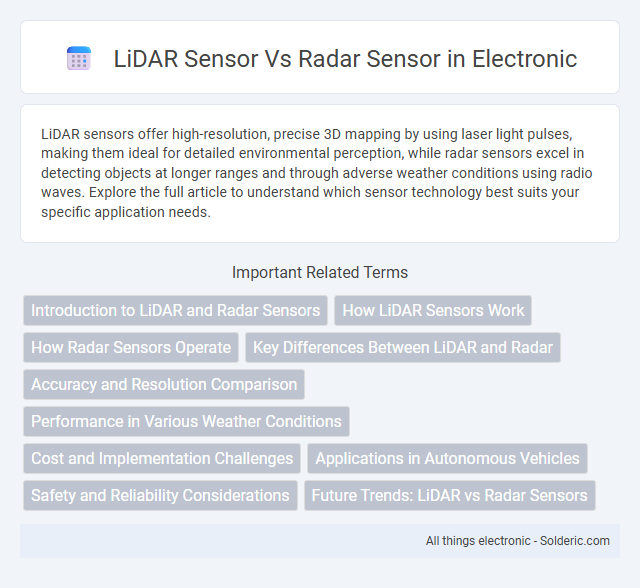LiDAR sensors offer high-resolution, precise 3D mapping by using laser light pulses, making them ideal for detailed environmental perception, while radar sensors excel in detecting objects at longer ranges and through adverse weather conditions using radio waves. Explore the full article to understand which sensor technology best suits your specific application needs.
Comparison Table
| Feature | LiDAR Sensor | Radar Sensor |
|---|---|---|
| Technology | Light Detection and Ranging using laser pulses | Radio Detection and Ranging using radio waves |
| Range | Short to medium (up to 200 meters) | Long-range (up to several kilometers) |
| Resolution | High spatial resolution (detailed 3D mapping) | Lower spatial resolution (object detection & speed measurement) |
| Performance in Adverse Weather | Affected by fog, rain, and dust | Robust in fog, rain, snow, and dust |
| Cost | Generally higher | Generally lower |
| Common Applications | Autonomous vehicles, topographic mapping, forestry | Automotive safety, air traffic control, weather monitoring |
| Data Output | 3D point clouds | Velocity, distance, and angle of objects |
| Power Consumption | Higher power consumption | Lower power consumption |
Introduction to LiDAR and Radar Sensors
LiDAR sensors use laser light pulses to create high-resolution 3D maps by measuring the reflection time, offering precise distance and spatial data. Radar sensors emit radio waves to detect objects and measure their speed and distance, performing reliably in various weather conditions. Both technologies play crucial roles in autonomous vehicles and advanced driver-assistance systems, each excelling in different environmental challenges and detection ranges.
How LiDAR Sensors Work
LiDAR sensors operate by emitting rapid laser pulses that bounce off surrounding objects to measure distances with high precision, creating detailed 3D maps of environments. Unlike radar sensors that use radio waves, LiDAR relies on light detection, enabling it to capture fine spatial details and object shapes accurately. This optical sensing method allows autonomous vehicles and mapping systems to recognize obstacles and terrain features with remarkable resolution.
How Radar Sensors Operate
Radar sensors operate by emitting radio waves that bounce off objects and return to the sensor, enabling precise detection of range, speed, and position even in adverse weather conditions. Unlike LiDAR, which uses light pulses, radar is highly effective for long-distance object detection due to its lower frequency signals penetrating fog, rain, and dust. Your vehicle's radar sensor continuously processes reflected signals to detect moving objects and ensure safety in dynamic environments.
Key Differences Between LiDAR and Radar
LiDAR sensors use laser light pulses to create highly detailed, 3D maps of surroundings, offering superior resolution and accuracy for object detection. Radar sensors emit radio waves that measure object distance and speed, performing better in adverse weather conditions like fog, rain, or dust. Your choice between LiDAR and radar depends on the required precision, environmental conditions, and application needs such as autonomous driving or surveillance systems.
Accuracy and Resolution Comparison
LiDAR sensors provide superior accuracy and higher resolution by emitting laser pulses that capture detailed 3D spatial data, making them ideal for precise object detection and mapping. Radar sensors offer longer-range detection and better performance in adverse weather but generally have lower resolution, resulting in less detailed images. Your choice should consider the need for fine spatial detail versus robustness in weather conditions.
Performance in Various Weather Conditions
LiDAR sensors offer high-resolution 3D mapping but can experience significant performance degradation in adverse weather conditions such as heavy rain, fog, or snow due to light scattering and absorption. Radar sensors, operating with radio waves, maintain reliable detection and range accuracy in poor weather environments since radio waves penetrate fog, rain, and dust more effectively. Therefore, radar sensors are preferred for consistent performance in all-weather scenarios, while LiDAR excels in clear conditions with detailed spatial information.
Cost and Implementation Challenges
LiDAR sensors typically cost significantly more than radar sensors due to their complex optical components and advanced signal processing requirements. Implementation challenges for LiDAR include sensitivity to weather conditions like fog, rain, and dust, which can degrade performance and reliability. In contrast, radar sensors offer lower costs and greater robustness in adverse environments but often provide less detailed spatial resolution compared to LiDAR.
Applications in Autonomous Vehicles
LiDAR sensors provide high-resolution 3D mapping crucial for precise object detection and lane marking in autonomous vehicles, enabling safer navigation in complex environments. Radar sensors excel in detecting objects at longer ranges and perform reliably in adverse weather conditions, enhancing vehicle awareness during fog, rain, or dust. Your vehicle benefits from the combined use of both sensors, leveraging LiDAR's spatial accuracy and radar's robust range detection to achieve optimal safety and performance.
Safety and Reliability Considerations
LiDAR sensors provide high-resolution 3D mapping with precise object detection, enhancing safety in autonomous systems by improving obstacle recognition and environmental awareness. Radar sensors offer superior reliability in adverse weather conditions, such as fog, rain, and dust, maintaining consistent performance when optical systems may fail. Combining LiDAR and radar technologies often results in a robust safety system, leveraging LiDAR's accuracy and radar's weather resilience for dependable autonomous navigation.
Future Trends: LiDAR vs Radar Sensors
Emerging advancements in autonomous vehicle technology highlight LiDAR sensors' superior resolution and accuracy for detailed 3D mapping, while radar sensors excel in long-range detection and adverse weather conditions. Future trends indicate hybrid sensor fusion systems integrating LiDAR's high-definition spatial data with radar's robust object velocity and range detection to enhance perception reliability. Research in solid-state LiDAR and advanced radar signal processing aims to reduce cost and improve sensor miniaturization, promoting widespread adoption in automotive and robotics industries.
LiDAR sensor vs radar sensor Infographic

 solderic.com
solderic.com